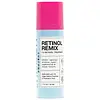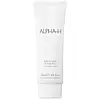What's inside
What's inside
 Key Ingredients
Key Ingredients

 Benefits
Benefits

 Concerns
Concerns

 Ingredients Side-by-side
Ingredients Side-by-side

Water
Skin ConditioningGlycerin
HumectantStearic Acid
CleansingCoco-Caprylate
EmollientCoconut Alkanes
EmollientGlycine Soja Oil
EmollientDimethicone
EmollientCaprylic/Capric Triglyceride
MaskingCetearyl Alcohol
EmollientArachidyl Alcohol
EmollientBis-Diglyceryl Polyacyladipate-2
EmollientPropanediol
SolventHydrogenated Polydecene
EmollientTranexamic Acid
AstringentGlyceryl Oleate Citrate
EmulsifyingRetinol
Skin ConditioningRetinal
Skin ConditioningN-Prolyl Palmitoyl Tripeptide-56 Acetate
Skin ConditioningHydroxypinacolone Retinoate
Skin ConditioningTasmannia Lanceolata Fruit/Leaf Extract
AntioxidantCentella Asiatica Leaf Extract
Skin ConditioningHyaluronic Acid
HumectantSodium Hyaluronate
HumectantCalendula Officinalis Flower Extract
MaskingAnthemis Nobilis Flower Oil
MaskingOryza Sativa Bran Extract
Skin ConditioningSimmondsia Chinensis Seed Oil
EmollientHaematococcus Pluvialis Extract
AntioxidantChamomilla Recutita Flower Extract
MaskingHelianthus Annuus Extract
EmollientRosmarinus Officinalis Leaf Extract
AntimicrobialHelianthus Annuus Seed Oil
EmollientCarthamus Tinctorius Seed Oil
MaskingAcacia Senegal Gum
MaskingXanthan Gum
EmulsifyingCoco-Glucoside
CleansingTetrahexyldecyl Ascorbate
AntioxidantGlucose
HumectantXanthophylls
Skin ConditioningLecithin
EmollientCoco-Caprylate/Caprate
EmollientCaprylyl Glycol
Emollient1,2-Hexanediol
Skin ConditioningCellulose Gum
Emulsion StabilisingSorbitan Isostearate
EmulsifyingHydroxyethyl Acrylate/Sodium Acryloyldimethyl Taurate Copolymer
Emulsion StabilisingBehenyl Alcohol
EmollientHydroxyacetophenone
AntioxidantArachidyl Glucoside
EmulsifyingDimethyl Isosorbide
SolventMicrocrystalline Cellulose
AbsorbentPentylene Glycol
Skin ConditioningSodium Phytate
Tocopherol
AntioxidantWater, Glycerin, Stearic Acid, Coco-Caprylate, Coconut Alkanes, Glycine Soja Oil, Dimethicone, Caprylic/Capric Triglyceride, Cetearyl Alcohol, Arachidyl Alcohol, Bis-Diglyceryl Polyacyladipate-2, Propanediol, Hydrogenated Polydecene, Tranexamic Acid, Glyceryl Oleate Citrate, Retinol, Retinal, N-Prolyl Palmitoyl Tripeptide-56 Acetate, Hydroxypinacolone Retinoate, Tasmannia Lanceolata Fruit/Leaf Extract, Centella Asiatica Leaf Extract, Hyaluronic Acid, Sodium Hyaluronate, Calendula Officinalis Flower Extract, Anthemis Nobilis Flower Oil, Oryza Sativa Bran Extract, Simmondsia Chinensis Seed Oil, Haematococcus Pluvialis Extract, Chamomilla Recutita Flower Extract, Helianthus Annuus Extract, Rosmarinus Officinalis Leaf Extract, Helianthus Annuus Seed Oil, Carthamus Tinctorius Seed Oil, Acacia Senegal Gum, Xanthan Gum, Coco-Glucoside, Tetrahexyldecyl Ascorbate, Glucose, Xanthophylls, Lecithin, Coco-Caprylate/Caprate, Caprylyl Glycol, 1,2-Hexanediol, Cellulose Gum, Sorbitan Isostearate, Hydroxyethyl Acrylate/Sodium Acryloyldimethyl Taurate Copolymer, Behenyl Alcohol, Hydroxyacetophenone, Arachidyl Glucoside, Dimethyl Isosorbide, Microcrystalline Cellulose, Pentylene Glycol, Sodium Phytate, Tocopherol
Water
Skin ConditioningGlycolic Acid
BufferingCaprylic/Capric Triglyceride
MaskingDimethicone
EmollientCetearyl Alcohol
EmollientGlyceryl Stearate
EmollientPEG-100 Stearate
Cyclopentasiloxane
EmollientEuglena Gracilis Extract
Skin ConditioningPotassium Hydroxide
BufferingCeteareth-20
CleansingSodium Carrageenan
Emulsion StabilisingGlycerin
HumectantStearic Acid
CleansingHydrolyzed Wheat Flour
Skin ConditioningPhenoxyethanol
PreservativeMaltodextrin
AbsorbentSimmondsia Chinensis Seed Oil
EmollientDimethicone Crosspolymer
Emulsion StabilisingParfum
MaskingButyrospermum Parkii Butter
Skin ConditioningMangifera Indica Seed Butter
Skin ConditioningPrunus Amygdalus Dulcis Oil
Skin ConditioningRetinol
Skin ConditioningTocopheryl Acetate
AntioxidantVitis Vinifera Seed Oil
EmollientPanthenol
Skin ConditioningTanacetum Annuum Flower Oil
MaskingGluconolactone
Skin ConditioningAllantoin
Skin ConditioningDisodium EDTA
Sodium Benzoate
MaskingAloe Barbadensis Leaf
MaskingCalcium Pantothenate
Xanthan Gum
EmulsifyingCaprylyl Glycol
EmollientProline
Skin ConditioningSerine
MaskingSodium Hyaluronate
HumectantUrea
BufferingMagnesium Lactate
BufferingPapain
Skin ConditioningEthylhexylglycerin
Skin ConditioningCalcium Gluconate
HumectantAlanine
MaskingMagnesium Chloride
Sodium Citrate
BufferingLimonene
PerfumingLinalool
PerfumingWater, Glycolic Acid, Caprylic/Capric Triglyceride, Dimethicone, Cetearyl Alcohol, Glyceryl Stearate, PEG-100 Stearate, Cyclopentasiloxane, Euglena Gracilis Extract, Potassium Hydroxide, Ceteareth-20, Sodium Carrageenan, Glycerin, Stearic Acid, Hydrolyzed Wheat Flour, Phenoxyethanol, Maltodextrin, Simmondsia Chinensis Seed Oil, Dimethicone Crosspolymer, Parfum, Butyrospermum Parkii Butter, Mangifera Indica Seed Butter, Prunus Amygdalus Dulcis Oil, Retinol, Tocopheryl Acetate, Vitis Vinifera Seed Oil, Panthenol, Tanacetum Annuum Flower Oil, Gluconolactone, Allantoin, Disodium EDTA, Sodium Benzoate, Aloe Barbadensis Leaf, Calcium Pantothenate, Xanthan Gum, Caprylyl Glycol, Proline, Serine, Sodium Hyaluronate, Urea, Magnesium Lactate, Papain, Ethylhexylglycerin, Calcium Gluconate, Alanine, Magnesium Chloride, Sodium Citrate, Limonene, Linalool
 Reviews
Reviews

Ingredients Explained
These ingredients are found in both products.
Ingredients higher up in an ingredient list are typically present in a larger amount.
This ingredient is an emollient, solvent, and texture enhancer. It is considered a skin-softener by helping the skin prevent moisture loss.
It helps thicken a product's formula and makes it easier to spread by dissolving clumping compounds.
Caprylic Triglyceride is made by combining glycerin with coconut oil, forming a clear liquid.
While there is an assumption Caprylic Triglyceride can clog pores due to it being derived from coconut oil, there is no research supporting this.
Learn more about Caprylic/Capric TriglycerideCaprylyl Glycol is a humectant and emollient, meaning it attracts and preserves moisture.
It is a common ingredient in many products, especially those designed to hydrate skin. The primary benefits are retaining moisture, skin softening, and promoting a healthy skin barrier.
Though Caprylyl Glycol is an alcohol derived from fatty acids, it is not the kind that can dry out skin.
This ingredient is also used as a preservative to extend the life of products. It has slight antimicrobial properties.
Learn more about Caprylyl GlycolCetearyl alcohol is a mixture of two fatty alcohols: cetyl alcohol and stearyl alcohol. It is mainly used as an emulsifier. Emulsifiers help prevent the separation of oils and products. Due to its composition, it can also be used to thicken a product or help create foam.
Cetearyl alcohol is an emollient. Emollients help soothe and hydrate the skin by trapping moisture.
Studies show Cetearyl alcohol is non-toxic and non-irritating. The FDA allows products labeled "alcohol-free" to have fatty alcohols.
This ingredient is usually derived from plant oils such as palm, vegetable, or coconut oils. There is debate on whether this ingredient will cause acne.
Due to the fatty acid base, this ingredient may not be Malassezia folliculitis safe.
Learn more about Cetearyl AlcoholDimethicone is a type of synthetic silicone created from natural materials such as quartz.
What it does:
Dimethicone comes in different viscosities:
Depending on the viscosity, dimethicone has different properties.
Ingredients lists don't always show which type is used, so we recommend reaching out to the brand if you have questions about the viscosity.
This ingredient is unlikely to cause irritation because it does not get absorbed into skin. However, people with silicone allergies should be careful about using this ingredient.
Note: Dimethicone may contribute to pilling. This is because it is not oil or water soluble, so pilling may occur when layered with products. When mixed with heavy oils in a formula, the outcome is also quite greasy.
Learn more about DimethiconeGlycerin is already naturally found in your skin. It helps moisturize and protect your skin.
A study from 2016 found glycerin to be more effective as a humectant than AHAs and hyaluronic acid.
As a humectant, it helps the skin stay hydrated by pulling moisture to your skin. The low molecular weight of glycerin allows it to pull moisture into the deeper layers of your skin.
Hydrated skin improves your skin barrier; Your skin barrier helps protect against irritants and bacteria.
Glycerin has also been found to have antimicrobial and antiviral properties. Due to these properties, glycerin is often used in wound and burn treatments.
In cosmetics, glycerin is usually derived from plants such as soybean or palm. However, it can also be sourced from animals, such as tallow or animal fat.
This ingredient is organic, colorless, odorless, and non-toxic.
Glycerin is the name for this ingredient in American English. British English uses Glycerol/Glycerine.
Learn more about GlycerinRetinol is a gold-standard ingredient for anti-aging. It is a form of Vitamin A and belongs to the class of retinoids that also includes tretinoin.
Why is retinol famous?
It has the most scientific studies backing up its skin benefits out of all the non-prescription ingredients.
Retinol is proven to:
This is why retinol is effective at removing wrinkles, fading dark spots, treating acne, and reducing the appearance of pores.
Studies show retinol is less effective when exposed to UV. Be sure to look for appropriate packaging to keep your retinol potent (similar to Vitamin C).
Using retinol or any retinoids will increase sun-sensitivity in the first few months. Though studies show retinoids increase your skin's natural SPF with continuous use, it is best to always wear sunscreen and sun-protection.
We recommend speaking with a medical professional about using this ingredient during pregnancy.
Retinol may cause irritation in some people, so be sure to patch test. Experts recommend 'ramping up' retinol use: start using this ingredient once a week and work up to using it daily.
Read about Tretinoin
Learn more about RetinolThis oil comes from the seeds of the desert shrub called Jojoba. It is more commonly known as jojoba oil, a non-comedogenic oil.
Jojoba oil does not contain fragrance and has many fatty-acids, making it a great soothing ingredient.
It also contains Vitamin E, a great moisturizing ingredient. Vitamin E is also an antioxidant and protects your skin against oxidative damage.
This ingredient humectant properties, meaning it helps draw moisture from the air. This helps keep your skin hydrated.
While jojoba has antibacterial properties, it is only able to kill some strains of bacteria.
Studies also show it helps in wound healing. In fact, Indigenous cultures have used jojoba as a moisturizer and to help treat burns for centuries.
Fun fact: Jojoba oil similar to natural human skin sebum, so it has a great effect on dry skin. It is also promising with helping to regulate sebum production.
Due to its fatty acid content, Jojoba oil may not be fungal acne safe. We recommend speaking with a professional if you have any concerns.
Learn more about Simmondsia Chinensis Seed OilSodium Hyaluronate is hyaluronic acid's salt form. It is commonly derived from the sodium salt of hyaluronic acid.
Like hyaluronic acid, it is great at holding water and acts as a humectant. This makes it a great skin hydrating ingredient.
Sodium Hyaluronate is naturally occurring in our bodies and is mostly found in eye fluid and joints.
These are some other common types of Hyaluronic Acid:
Learn more about Sodium HyaluronateStearic Acid is a fatty acid. It is an emollient, emulsifier, and texture enhancer.
As an emollient, stearic acid helps soften skin. It aids the skin's protective barrier by preventing water loss. It also provides a gentle cleansing effect without stripping away natural oils.
Stearic acid may also be used to enhance the texture of products. It can add volume and stabilize ingredients such as water and oil. This can help water and oil ingredients from separating.
Sources of stearic acid include animal or vegetable fats/oils such as coconut or shea. It can be naturally found in butter, cocoa butter, shea butter, vegetable fats, and animal tallow.
This ingredient may not be Malassezia folliculitis, or fungal-acne safe.
Learn more about Stearic AcidWater. It's the most common cosmetic ingredient of all. You'll usually see it at the top of ingredient lists, meaning that it makes up the largest part of the product.
So why is it so popular? Water most often acts as a solvent - this means that it helps dissolve other ingredients into the formulation.
You'll also recognize water as that liquid we all need to stay alive. If you see this, drink a glass of water. Stay hydrated!
Learn more about WaterXanthan gum is used as a stabilizer and thickener within cosmetic products. It helps give products a sticky, thick feeling - preventing them from being too runny.
On the technical side of things, xanthan gum is a polysaccharide - a combination consisting of multiple sugar molecules bonded together.
Xanthan gum is a pretty common and great ingredient. It is a natural, non-toxic, non-irritating ingredient that is also commonly used in food products.
Learn more about Xanthan Gum